The Old Kuala Lumpur Railway Station - One of the most beautiful railway stations in the world
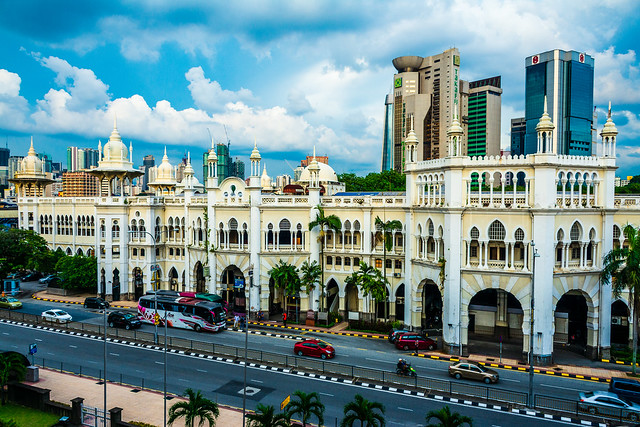 |
| The main entrance and the south wing of the railway station |
The next most prominent landmark of Kuala Lumpur among the historic buildings after the Sultan Abdul Samad Building is certainly the old Kuala Lumpur Railway Station.
Architectural Digest, an international magazine on architecture and design, published a list of the 26 world’s most beautiful train stations on their online publication on 1 October 2014 and placed the Kuala Lumpur’s Old Railway Station at No. 4 among 25 other train stations including Gare du Nord in Paris, Rotterdam Central Station in Rotterdam, Chhatrapati Shivaji Terminus in Mumbai and Grand Central Terminal in New York.
In fact since it was opened on 1 July 1911 the old Kuala Lumpur Railway Station never failed to amaze various foreign travellers who came to Kuala Lumpur by train.
Ashley Jackson in his book, Buildings of Empire, wrote that in 1913 J.F. Dijkotra, a visitor from the Dutch East Indies, beheld Kuala Lumpur Railway Station with something approaching rapture:
"Out of proportion to the place...you cannot imagine yourself in the East. Going from the town of Kuala Lumpur to the Station is like going to the Gare du Nord in Paris. The Station is high like that in Weisbaden, and clean as the Central Station at Amsterdam, and hospitable as a London terminus".Ashley Jackson further wrote: "The Taj Mahal of the Train World” was how others described this arresting snow-white building. 'There isn't a station anywhere to touch it', wrote the well-travelled Scottish railway enthusiast Adam Saylor. It gives a sense of an architect pining to create a Sultan's palace. It rose sixty years ago, like a chandelier in a slum. Kuala Lumpur was a pretty tawdry township, a community characterised by clusters of attap roofs".
The old Kuala Lumpur Railway Station is actually the third Kuala Lumpur’s main railway station, and by far the longest lived of the three. The first Kuala Lumpur railway station was opened in 1886 with the opening of the first Kuala Lumpur line from Bukit Kuda in Klang to Kuala Lumpur, a distance of 19.5 miles (approximately 31.4km) on 15 September 1886. It was located about 1km north of the present building which according to JM Gullick in his book, A history of Kuala Lumpur 1857-1939, stood at the corner of Market Street (now Lebuh Pasar Besar) and Victory Avenue (now Jalan Sultan Hishamuddin). JHM Robson in his Records and Recollections (1889-1934) also described the first Kuala Lumpur Railway Station in 1889 as follows:
“The Kuala Lumpur Railway Station was on the site of the present P.W.D offices". (now the National Textile Museum). “It was little more than a glorified shed”.
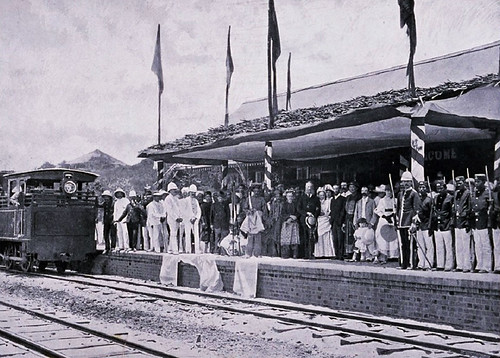 |
| The very first Kuala Lumpur Railway Station on 15 September 1886 during the opening of the first railway line in Selangor (Photo credit: skyscrapercity.com Forum) |
After a while, the expanding railway system and the rapid growth of the town itself necessitated a grander edifice. The second station completed in 1892 was located on the present site and was a structure of considerable pretension set among an ensemble of minor buildings. This station, however, lasted only 15 years before it too was declared obsolete. Unfortunately this station was totally demolished to make way for the present one.
 |
| The 1892 Station which was later replaced by the present old Kuala Lumpur Railway Station. Picture credit: http://searail.malayanrailways.com |
 |
| The main building of the 1892 Station. Picture credit: http://searail.malayanrailways.com |
The decision to build a new station was made in late 1906. Once again the architect entrusted with the design was Arthur Benison Hubback (AB Hubback) whose official position at that time was Architectural Assistant. He was working under Charles Edwin Spooner (CE Spooner) who was holding the post of the General Manager of FMS Railways. Having worked in Ceylon before he was transferred to Kuala Lumpur, CE Spooner is believed to have been instrumental in introducing Indo-Saracenic style of British India to British Malaya.
CE Spooner arrived in Selangor on 15 November 1891 and was appointed State Engineer of Selangor to overhaul Public Works Department besides overseeing the upcoming “mega project” which was the construction of the new Government Offices (now the Sultan Abdul Samad Building). AB Hubback arrived later on 5 July 1895.
The design work by AB Hubback took about more than 4 months from late 1907 to the fourth month of 1908. Upon completion of the design CE Spooner took with him no less than 9 alternative options to an interview with the High Commissioner, Sir John Anderson, in Singapore in May 1908. The scheme chosen by Sir John Anderson was the middle one of the nine and a total budget of $687,680 (Straits Dollar) was simultaneously approved. Besides the train station and its relevant offices the proposed station would also comprise 16-room hotel for the convenience of passengers who needed accommodation close to the station.
ARCHITECTURAL FEATURES
The architectural style of the old Kuala Lumpur Railway Station is often mistaken for Moorish or Neo-Moorish architecture when it actually is Neo-Mughal architecture or more popularly known as Indo-Saracenic architecture or sometimes it is also referred to as British Raj architecture.
The style was imported directly from British India where the Indo-Saracenic style movement started in 1870 and it reached the height of its popularity among British architects in British India between late 19th century and early 20th century.
According to JM Gullick in his journal entitled The Bangunan Sultan Abdul Samad, it was CE Spooner, having worked in Ceylon before, who was responsible for introducing Indo-Saracenic architecture to Malaya (with strong support by the then Resident of Selangor, William Maxwell) starting with the Sultan Abdul Samad Building. Spooner at that time referred to this architectural style as “Mahometan” (sic) style. Mahometan is suspected to be the misspelling of Muhammadian - the term used by the British before in referring to Muslim. So Mahometan style on Spooner's term was the architectural style that suited Selangor, a Muslim-majority state.
The most conspicuous feature of the whole complex is its octagonal towers that flank the central block as well as the gables at both end of the extended platform canopy. Each octagonal tower which encases staircase is topped with chhatri, (a mini pavilion-like structure with dome on the top) a prominent feature of Mughal architecture whose lineage can be traced back to the Mughal Emperor Akbar’s 16th century and the civic buildings in India during the rule of British Raj.
In addition to the octagonal towers with chhatri, multiple shapes and sizes of arches namely horseshoe arches, ogee arches and keyhole arches can be found running along the 450ft long structure. These arches serve to shade the loggia along the building from the harsh tropical sunlight besides providing airy ambience to the loggia. Scallop arches can also be spotted on each chhatri - another iconic feature of Mughal architecture.
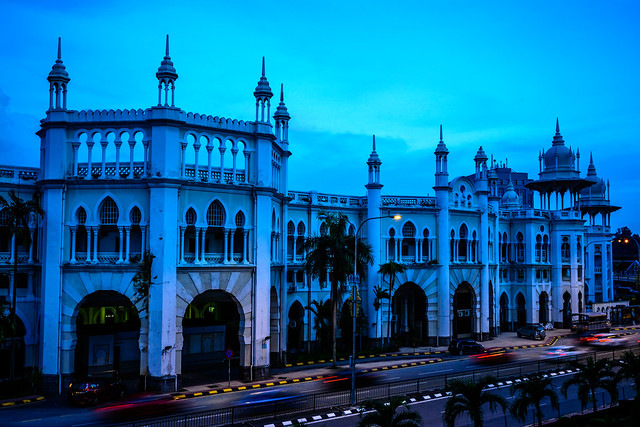 |
| Row of arches |
 |
| The scalloped arches of the chhatri on top of the octagonal tower |
The Malay Mail dated 12 May 1910 reported that the construction of the Kuala Lumpur Railway Station was near completion. It stated that the new station complex covered an area of about 14,000 square feet (3.3 acres). The complex consisted of a large station building and a great deal of additional space, besides three platforms, connected by two sub-ways – one with stairs for passengers and the other slope for luggage.
The construction work of foundations, subways and platforms were undertaken by the local contractor, Towkay Ang Seng Mooi while the roofing was done by PWD Selangor itself. Platforms were covered by a steel-framed roof that was glazed and partially open to allow smoke from steam locomotives to escape and the station to breathe.
Meanwhile the construction of the main building was assigned to Messrs. J.A. and P.C. Russell. The main building fronted on to Damansara Road (now Jalan Sultan Hishamuddin) and measured about 450 feet long by 150 feet wide. It would have two storeys with a mezzanine floor between them.
The Malay Mail dated 12 May 1910 reported:
The upper part of the building rests upon rows of columns outside the main entrance to the station forming a covering to protect passengers arriving at, or departing from, the station, from the vagaries of the weather. This upper part of the building will contain the 16 bedrooms of the station hotel, their verandahs and bathroom – the later in the mezzanine storey. The lower portion will be occupied by the station offices, waiting and refreshment rooms.The Malay Mail in the same report further added:
The main entrance leads direct into a large booking hall now nearly finished. On the left are large staircase to the hotel bedrooms, the first class waiting rooms and a spacious refreshment nearing completion, while beyond this gain will be boys' quarters, the site of which is now occupied by the old station. To the right of the main booking hall are first the luggage offices, then a large third class waiting room and lastly the station store room, all practically completed.The report concluded that the new station, which was the third since the Kuala Lumpur-Bukit Kuda line was opened, would not only provide great comfort and convenience to the passengers but would also be a worthy addition to the handsome public offices of which the inhabitants of Kuala Lumpur were so justly proud.
 |
| The old Kuala Lumpur Railway Station in 1910. Picture credit: http://searail.malayanrailways.com |
The Kuala Lumpur Railway Station was opened on 1 July 1911. Among the first passengers who used the stations were H.M. Sultan Alauddin Suleiman Shah, The Sultan of Selangor and Sir John Anderson, the British Governor of the Straits Settlements. Whereas the hotel operation commenced on 11 August 1911.
The grand total of the construction cost was reported to have amounted to $742,980 Straits Dollars. The cost included straightening a portion of the Klang River, a temporary station, dismantling the staff quarters and re-erecting them on a new site in Brickfields (where they still stand today).
This Station served as the main Kuala Lumpur Railway Station since 1911 for so many years and during that period it underwent several renovations. Among the major one was in the 1950's when an additional wing was constructed on the north wing of the building due to the growing number of passengers and the expanding business of the railway services.
Subsequently various major renovation work was carried out between August 1983 and April 1987. Among others were a completely new identical four-storey block added to the south wing, a facade of sufficient depth to provide sun screening added to the existing hybrid north wing, creating a new rear entrance facade as well as replacement of some decaying domes with concrete ones.
The renovation work however was done while the station was in operation as usual so it was a complex phased programme which was further complicated by the need for each package of work to have separate funding approval from the government. hence the long duration of almost 4 years taken to complete the work.
THE END OF AN ERA
With the opening of KL Sentral (a new and modern central hub for intra-city and intercity railway services) on 16th April 2001, it marked the end of an era for the venerable Kuala Lumpur railway station after having rendered its service for about 90 years. KL Sentral since 16 April 2001 has taken over as the main Kuala Lumpur railway station.
However the Kuala Lumpur Railway Station has been put to good use by functioning as the Kuala Lumpur station for intra-city Komuter electric train. The building is still standing strong today amidst rapid development around it.
However the Kuala Lumpur Railway Station has been put to good use by functioning as the Kuala Lumpur station for intra-city Komuter electric train. The building is still standing strong today amidst rapid development around it.
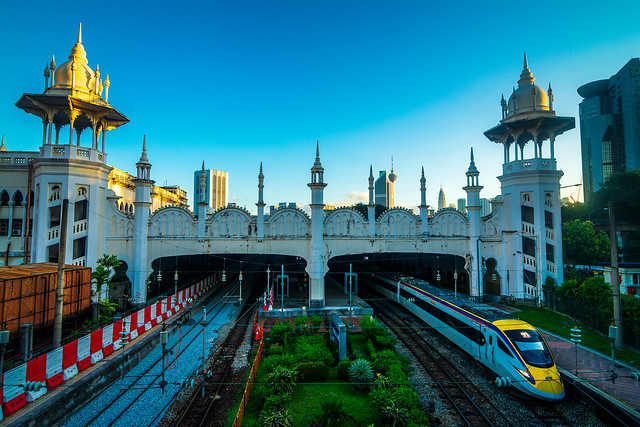 |
| Now the Old Kuala Lumpur Railway Station serves as the Kuala Lumpur Station for intra-city Komuter electric train |
The old Kuala Lumpur Railway Station was gazetted as heritage building in 1983 under the Antiquities Act 1976. Its Gazette No./Date is P.U. (A) 142 - 22/3/1983. On 1 March 2006 The National Heritage Act 2005 [Act 645] came into force by abolishing the two previous Acts, the Antiquities Act 1976 and Treasure Trove Act 1957.
Although I wish greater care was taken of this building that befits its status as one of the most beautiful train stations in the world and a national treasure, I am still grateful that this building still remains intact as our priceless architectural heritage that still stands in all its glory.
PHOTO TIPS
[Updated on 15 August 2021]
Although I wish greater care was taken of this building that befits its status as one of the most beautiful train stations in the world and a national treasure, I am still grateful that this building still remains intact as our priceless architectural heritage that still stands in all its glory.
PHOTO TIPS
As the front facade and its main entrance face west, the best time to photograph this handsome edifice is in the late evening when its front facade is bathed in the warm low-angled evening sunlight whenever the weather is clear. However if you are lucky, the glorious sunrise or sunset skies can act as a beautiful background against the silhouetted chhatris and numerous spires piercing the skies, at that time you can shoot from any angles you deem fit - the sky's the limit to your creativity so to speak. Perhaps this is one of the most photographed train stations in the world and it definitely is in Malaysia.
 |
| The main entrance of the old Kuala Lumpur Railway Station |
 |
| The silhouette of the ornamental archways, spires and modern high-rises against beautiful skies at dawn |
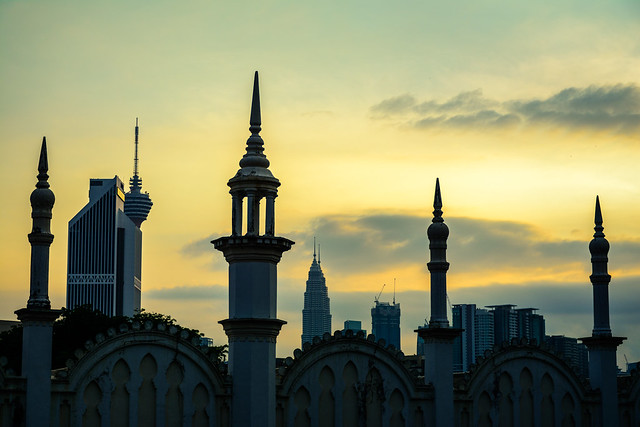 |
| The ornamental archways over the tracks, chhatri and spires together with modern skyscrapers pierce the early morning sky of Kuala Lumpur |
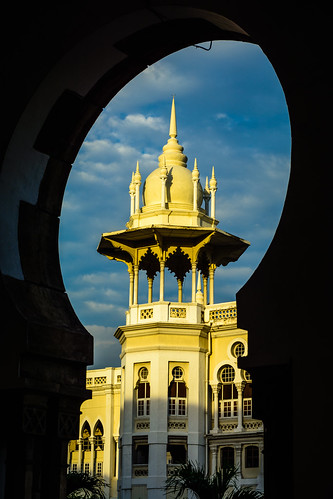 |
| A chhatri illuminated by the golden late evening light is framed the horseshoe arch of the KTM (The Malayan Railway Services) headquarters building. |
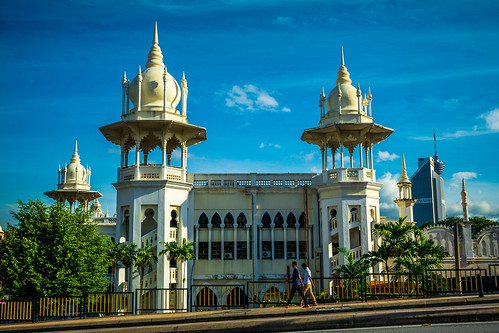 |
| The south wing of the building |
[Updated on 15 August 2021]
REFERENCES:
Asian Railways. (2015). Pictorial History of Railways around Kuala Lumpur. Retrieved from http://searail.malayanrailways.com/Selangor/Selangor%20Early%20pictures.htm
Chin, K.Y., & Chen, V.F. (1998). Kuala Lumpur, a sketchbook. Singapore: Archipelago Press.
Cooper, D., & Nurzaifullah Mansor. (2007, April-June). The gazetted buildings of Kuala Lumpur. Buletin Warisan, 7-8.
Gullick, J.M. (2000). A history of Kuala Lumpur 1857-1939. Kuala Lumpur: MBRAS.
Jackson, A. (2013). Buildings of empire. London: Oxford University Press.
Kuala Lumpur. Progress of new station described. (1910, May 12). Malay Mail.
Kuala Lumpur's new station. (1911, March 10). The Straits Times, p.7.
Robson, J.H.M. (1934). Records and Recollections (1889-1934). Kuala Lumpur: Kyle & Palmer Co. Ltd.
Stocker, P. (1986). Kuala Lumpur Railway Station. Majallah Akitek, 3&4, 22-30.
Asian Railways. (2015). Pictorial History of Railways around Kuala Lumpur. Retrieved from http://searail.malayanrailways.com/Selangor/Selangor%20Early%20pictures.htm
Chin, K.Y., & Chen, V.F. (1998). Kuala Lumpur, a sketchbook. Singapore: Archipelago Press.
Cooper, D., & Nurzaifullah Mansor. (2007, April-June). The gazetted buildings of Kuala Lumpur. Buletin Warisan, 7-8.
Gullick, J.M. (2000). A history of Kuala Lumpur 1857-1939. Kuala Lumpur: MBRAS.
Jackson, A. (2013). Buildings of empire. London: Oxford University Press.
Kuala Lumpur. Progress of new station described. (1910, May 12). Malay Mail.
Kuala Lumpur's new station. (1911, March 10). The Straits Times, p.7.
Robson, J.H.M. (1934). Records and Recollections (1889-1934). Kuala Lumpur: Kyle & Palmer Co. Ltd.
Stocker, P. (1986). Kuala Lumpur Railway Station. Majallah Akitek, 3&4, 22-30.


My spouse and I stumbled over here from a different website and thought I might as well check things out.
ReplyDeleteI like what I see so i am just following you. Look forward to looking into your web page again.
Thank you for dropping on at my blog and am glad if the information benefits you in any way.
DeleteNice blog here! Also your site loads up fast! What host are you using?
ReplyDeleteCan I get your affiliate link to your host? I wish my web site loaded up as quickly as yours lol
"Your Article is Good
ReplyDeleteHigh-Quality Refurbishment And Redevelopment Services In Malaysia"
"Your Article is Good
ReplyDeleteHigh-Quality Refurbishment And Redevelopment Services In Malaysia"
Very informative article. Thanks.
ReplyDeleteThank you for your favourable comment :)
DeleteAmazing blog, thanks for sharing. At a time when internet popularity is spreading at a rapid pace its important that you use this platform for knowing about different things easily. Reporters as well as bloggers from different portals of the world are updating these blogs on regular basis.
ReplyDeleteSecurity Company Bexleyheath
Security Company Dartford
Security Company Welling
Security Company Greenhithe
Security Company Gravesend
Security Company Bromley
Security Company Sidcup
Security Company Woking
Security Company Staines
Security Company Redhill
Security Company Croydon
Security Company Wimbledon